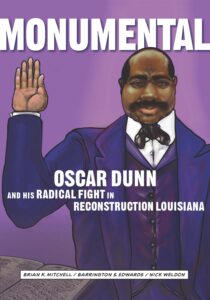Celebrating a Monumental Life
A graphic novel illustrates Reconstruction
Published: November 29, 2020
Last Updated: February 28, 2021

The Historic New Orleans Collection
A few months after reading his dissertation I reached out to Mitchell, a history professor at the University of Arkansas–Little Rock, and soon we were discussing publishing his research. He wasn’t interested in making a conventional scholarly book, though—he wanted to create a graphic novel. Or, perhaps more accurately, a “graphic history,” a growing nonfiction subgenre in a category typically dominated by the likes of Marvel and DC Comics. A prominent recent example is the late Congressman John Lewis’s acclaimed autobiographical trilogy, March. In recent years, Frederick Douglass, Zora Neale Hurston, the Beat movement, the atomic bomb, and other historical subjects have received the graphic novel treatment. Dunn’s story certainly merited an ambitious project, and with the blessing of THNOC’s board of directors, then president and CEO Priscilla Lawrence, and her successor, Daniel Hammer, we got to work.
I began developing a script adaptation of Mitchell’s research that would translate to the graphic novel page, while conducting a national search for an illustrator. Edwards, an artist, teacher, and activist from Boston, quickly emerged as our choice. It was essential that his artwork accurately reflect the era of Reconstruction in Louisiana, so I made him a reference database of period photographs and illustrations—many of which came from THNOC’s holdings. Edwards flew down to New Orleans, and Mitchell and I toured him around, showing him extant landmarks while he sketched and soaked in the timeless atmosphere of the city.
Edwards’s work took place in stages, beginning in the summer of 2018 with pencil sketches and eventually graduating to digital black-and-white inks and full-color images. Each round of art was met with meticulous edits to adjust for accuracy as well as narrative flow. In the meantime, I worked with Mitchell to hammer out the book’s array of supplementary materials: essays, a map, a timeline, endnotes, and more. Our goal from the beginning of the project was to create a book that retained the academic rigor of a more scholarly title while expanding its reach to lay readers as well as younger audiences. Every page of the graphic novel is supplemented by copious endnotes and commentary, for readers who want to dig even deeper into the material.
The job of weaving all of these materials together into one elegant physical book went to Tana Coman, a masterful local book designer and longtime THNOC collaborator. In addition to her typical responsibilities as a designer, she shouldered the intricate task of creating the “lettering” of the graphic novel—placing all of the script’s captions and dialogue into Edwards’s artwork. In the late stages, local illustrator Roan Smith assisted Coman in fine-tuning the design of the graphic novel pages. Throughout, the project has received crucial assistance from virtually every department at THNOC: that the creation of this book has been an, erm, monumental undertaking.
The finished product is something of a hybrid: a compelling graphic narrative enhanced by serious scholarly and educational materials. We hope this unique treatment will help Monumental reach a wide range of readers, and bring greater attention to the life and work of Oscar Dunn and the era of Reconstruction in Louisiana.
